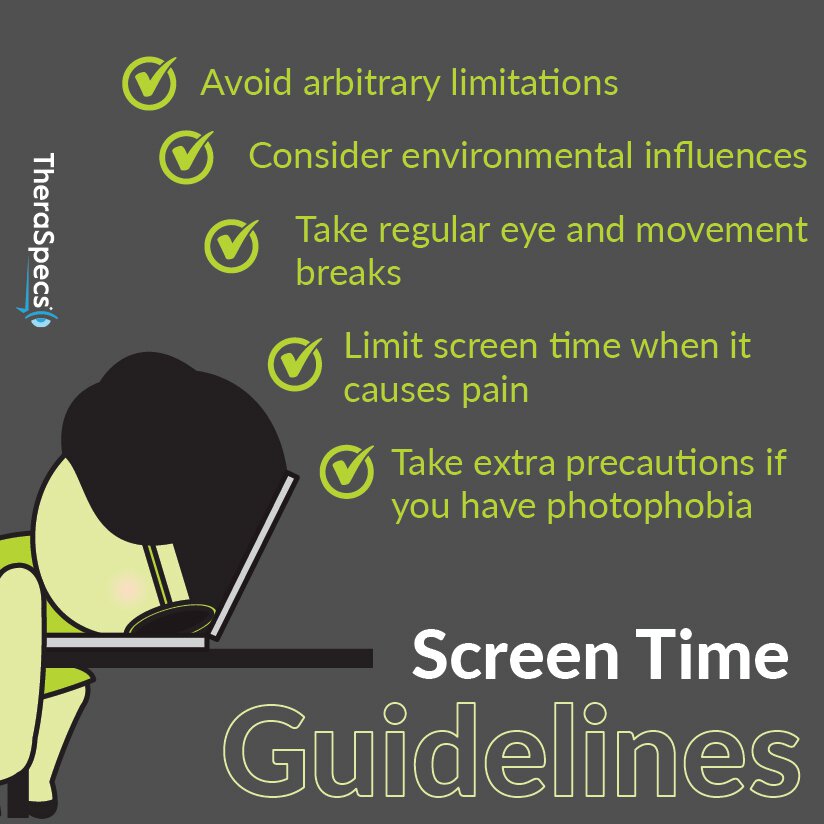Too Much Screen Time: Negative Effects, Symptoms and Guidelines
We have all heard a lot about the impact of screen time on our overall health and wellbeing, from the dangers of blue light exposure to the negative effects of social media dependency. But how much is too much screen time? And what are the actual consequences you might experience? We turn to the experts and researchers for a fresh take on screen use guidelines.
The Effect on the Eyes
The question comes up again and again: does looking at our screens for too long lead to eyesight problems, particularly later in life? The clinical evidence around this topic is inconclusive, with some recent studies suggesting a possible association between more screen time and the presence of myopia, or nearsightedness.1 Exposure to higher energy blue light, which does emanate from our devices, also has been linked to changes in eyesight over time. But again, the truth is we just don’t know with any certainty.

Digital eye strain and related symptoms
There are a multitude of temporary symptoms that fall under the umbrella term “digital eye strain” and are associated with computer and device use. The reported complaints include:
- Eye pain
- Eye redness, itching
- Blurry vision
- Headache
- Migraine
- Sensitivity to light
- Dry eyes
Although there are conflicting opinions about the extent to which screens cause these symptoms (and even how they cause them), we can’t deny that millions of people have felt these effects after long hours on their devices.
Research also indicates that increased screen time worsens these problems, even among healthy individuals. For example, dry eye symptoms were more prominent and severe among young adults, and the risk for migraine-like headache (along with other sensory symptoms) also increased with a longer duration of exposure—specifically, several hours per day.2,3 General headache complaints were also more likely when watching television or playing video/computer games for more than 3 hours per day.4
The COVID-19 pandemic, which began widely in spring 2020, has resulted in more time in front of a screen as well. One study found that more than a third of children were using their devices in excess of 5 hours per day, an astonishing 16x increase from before the pandemic. Researchers also found that 50% of kids had signs of digital eye strain, with approximately 10% exhibiting severe symptoms—most commonly itching around the eye and headache.5 This massive increase in daily exposure was a risk factor for these problems.
More risk if you have light sensitivity
What about for people who are already sensitive to light? Excess screen time poses a particular problem for them because their light sensitivity (also known as photophobia) is the result of additional brain hyperreactivity to wavelengths of blue light (which is present in screen light), even in otherwise acceptable viewing conditions. This means people diagnosed with migraine or survivors of brain injury are among those vulnerable to screen exposure—but there are dozens of conditions that can cause photophobia!
Other symptoms beyond those associated with digital eye strain can manifest too because light can trigger or worsen just about any symptom of a light-sensitive condition. So an individual with post-concussion photophobia might also experience the onset of dizziness or fatigue (if those are regular symptoms) due to their exposure to screen light.
Moreover, we can’t even quantify how much is “too much” screen time for this audience because a few minutes of light exposure can aggravate a light-sensitive brain. At minimum, the evidence shows that longer amounts of time in front of a computer or television screen increase the likelihood of an eventual attack or symptomatic period.
The COVID-19 pandemic has had an equally dramatic impact on those with light sensitivity. The rise in device usage, which was reported among nearly 80% of patients with photophobia, is believed to directly cause an increase in related symptoms. Many even acknowledged that their screen time had increased by 3 or more hours per day, with headaches, migraines and light-related pain among the top complaints that were occurring more frequently. On the other hand, some have seen a reduction in symptoms, which may indicate greater adaptation to our new normal as well as enhanced control over their immediate environment.
Other physical and emotional symptoms
In addition, there can be non-eyestrain symptoms that stem from our screen viewing, such as neck and shoulder discomfort, and back pain. Similarly, greater exposure (2-5 hours or more) exacerbates the risk for these symptoms.6 Of course, other factors may complicate the presence of these physical issues, such as obesity, exercise (or lack thereof), and general posture while viewing screens, so it may not be the result of any one cause.
We must also consider the emotional side effects of a reliance on our screens. Multiple studies have linked depression, anxiety, and irritability with higher levels of device usage. Overall, people who spend excessive amounts of time in front of a screen have less emotional stability.7,8 However, it is important to remember that there are a variety of potential ingredients that can stir the emotional pot for an individual.

Screen time guidelines
With all this information, it might be easy to want to cut out electronic devices entirely or at least severely limit their use. But that may not be necessary or even preferred—let alone possible—in today’s world. The fact is there remains no consensus around what constitutes excess screen time, and even then most of the research centers around its effects on children and teens. This translates to a lack of nuance that is required to be impactful for the broader population.
We have to also consider the complicating factors beyond just screen light exposure. For instance, several hours of uninterrupted device usage without any breaks or physical movement can absolutely harm your body and lead to the aforementioned symptoms, regardless of the amount of time you spend. Viewing a brightly-lit screen in a darkened room can also aggravate your eyes because of the sharp contrast of lighting conditions. Experts also generally agree that exposing your eyes and brain to screen light in the 1-2 hours before bed can affect your sleep and how you feel the next day. As a result, we cannot view time alone as the only important consideration.
In addition, the type of activity that involves electronics might matter. Experts have shown that if kids and adolescents are performing educational or learning tasks, the outcomes are all-around positive for health and wellbeing. Conversely, “passive” screen viewing (such as television watching) is more likely to cause the kind of problems associated with excessive screen time.9
So how should we guide ourselves (and our children) on their screen time? We have a few recommendations:
- Avoid arbitrary screen time limitations. In particular, when screen time is less than 4-5 hours per day and/or for healthy adolescents and adults.
- Consider environmental factors. Increase ambient lighting, avoid poor neck or body posture and limit screen use before you go to sleep—all of which can reduce the onset of negative side effects.
- Take regular eye and movement breaks. If you know you’re going to be spending a lot of time on the computer or smartphone, make sure you take frequent eye breaks and move around.
- Limit screen time when it causes pain or symptoms. If your exposure to screen light causes you pain or other issues, even if you aren’t inherently light sensitive, you should consider taking an extended break away from your devices.
- Take extra precautions if you have photophobia. Protective blue light glasses, screen light filters and apps, and lower amounts of screen exposure can help minimize the risk of developing symptoms if you already have light sensitivity.
We hope this has given you the kind of actionable information to make the decision that best fits your health needs.
More Screen Time Guidelines and Tips:
Screen Time After a Concussion: Should You Limit the Use of Electronics?
12 Smartphone Hacks to Stay Headache and Migraine-Free on Mobile
Here's Why Smartphones Can Hurt Our Eyes and Cause Headaches
References:
1Lanca C, Saw SM. The association between digital screen time and myopia: A systematic review. Ophthalmic Physiol Opt. 2020;40(2):216-229. doi:10.1111/opo.12657
2Pang Y, Madro S, Hobi D, Tea Y. Effect of Screen time on Dry Eye Symptoms in Young Adults. Investigative Ophthalmology & Visual Science. 2020;61(7):341.
3Montagni I, Guichard E, Carpenet C, Tzourio C, Kurth T. Screen time exposure and reporting of headaches in young adults: A cross-sectional study. Cephalalgia. 2016;36(11):1020-1027. doi:10.1177/0333102415620286
4Brindova D, Veselska ZD, Klein D, et al. Is the association between screen-based behaviour and health complaints among adolescents moderated by physical activity?. Int J Public Health. 2015;60(2):139-145. doi:10.1007/s00038-014-0627-x
5Mohan A, Sen P, Shah C, Jain E, Jain S. Prevalence and risk factor assessment of digital eye strain among children using online e-learning during the COVID-19 pandemic: Digital eye strain among kids (DESK study-1). Indian Journal of Ophthalmology. 2021;69(1):140. doi:10.4103/ijo.ijo_2535_20.
6Hakala PT, Rimpelä AH, Saarni LA, Salminen JJ. Frequent computer-related activities increase the risk of neck–shoulder and low back pain in adolescents. European Journal of Public Health. 2006;16(5):536-541. doi:10.1093/eurpub/ckl025.
7Madhav KC, Sherchand SP, Sherchan S. Association between screen time and depression among US adults. Preventive Medicine Reports. 2017;8:67-71. doi:10.1016/j.pmedr.2017.08.005.
8Twenge JM, Campbell WK. Associations between screen time and lower psychological well-being among children and adolescents: Evidence from a population-based study. Preventive Medicine Reports. 2018;12:271-283. doi:10.1016/j.pmedr.2018.10.003.
9Sanders T, Parker PD, del Pozo-Cruz B, Noetel M, Lonsdale C. Type of screen time moderates effects on outcomes in 4013 children: evidence from the Longitudinal Study of Australian Children. International Journal of Behavioral Nutrition and Physical Activity. 2019;16(1). doi:10.1186/s12966-019-0881-7.
TheraSpecs Glasses for Light Management
Try our light-filtering glasses and stay protected against harsh light from screens, fluorescents, LEDs, unwanted blue light, bright sunlight, flashing lights, and more.





